John Strutt Peyton | |
|---|---|
| Born | 14 January 1786 London, England |
| Died | 20 May 1838 (aged 52) London, England |
| Allegiance | |
| Service/ | |
| Years of service | 1797–1838 |
| Rank | Captain |
| Battles/wars | |
Sir John Strutt Peyton, KCH (1786–1838) was a captain in the Royal Navy.
John Strutt Peyton | |
|---|---|
| Born | 14 January 1786 London, England |
| Died | 20 May 1838 (aged 52) London, England |
| Allegiance | |
| Service/ | |
| Years of service | 1797–1838 |
| Rank | Captain |
| Battles/wars | |
Sir John Strutt Peyton, KCH (1786–1838) was a captain in the Royal Navy.
John Strutt Peyton, born in London on 14 January 1786, was the son of William Peyton of the Navy Office, grandson of Admiral Joseph Peyton, and great-grandson of Commodore Edward Peyton. His father's three brothers, too, were all in the navy; one of them, John, who died a rear-admiral in 1809, was captain of the Defence in the Battle of the Nile. His grandmother was a daughter of Commander John Strutt; his mother was the daughter of Commander Jacob Lobb, who died in command of the Kingfisher sloop on the American station in 1773, and was sister of Captain William Granville Lobb, afterwards a commissioner of the navy. [1]
Peyton went first to sea in October 1797, on board the Hector , off Cadiz; was then for three years in the Emerald in the Mediterranean, and in January 1801 was appointed to the San Josef , Nelson's flagship in the Channel. With Nelson he was moved to the St. George , in which he was in the Baltic and afterwards off Cadiz and in the West Indies, for part of the time under the command of his uncle, Captain Lobb. During 1802–3 he served, in quick succession, in several frigates in the Channel or in the North Sea, and in August 1803 was sent out to the Victory , carrying Nelson's flag off Toulon. In March 1805 he was appointed acting-lieutenant of the Canópus , from which he was moved in May to the Ambuscade frigate with Captain William Durban, employed during the next two years in the Adriatic. Peyton's commission as lieutenant was dated 7 October 1805. In July 1807, having been sent to destroy a vessel which ran herself ashore near Ortona, he was wounded in the right elbow by a musket-bullet; the arm had to be amputated, and he was invalided. [1]
On 1 December 1807 he was promoted to the rank of commander, and from June 1809 to February 1811 he commanded the Ephira brig in the North Sea, in the Walcheren expedition, and afterwards off Cadiz. He was then appointed to the Weazel in the Archipelago; and on 26 September 1811 was posted to the Minstrel of 20 guns, in which, and afterwards in the Thames , he was employed on the coast of Valencia and Catalonia till near the end of the war, during which time he was repeatedly engaged with the enemies' batteries and privateers, and received the thanks of Sir Edward Pellew, the commander-in-chief. In September 1813 the Thames returned to England and was paid off. On 25 January 1836 he was nominated a KCH, and in June 1836 was appointed to the Madagascar of 46 guns, in which he went out to the West Indies. [2]
He married, in 1814, a daughter of Lieutenant Woodyear, Royal Navy, of St. Kitts. They had three daughters and two sons, the elder of whom, Lumley Woodyear, died a retired commander in 1885. [3]
In the spring of 1838 Peyton was compelled to invalid. John Strutt Peyton died in London on 20 May. [3]
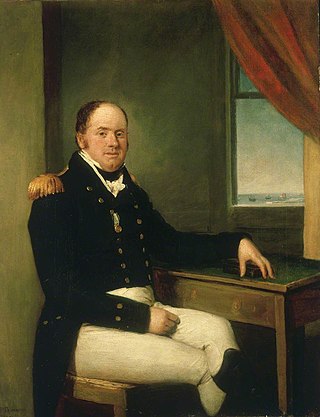
Vice-Admiral Sir Thomas Masterman Hardy, 1st Baronet, GCB was a British Royal Navy officer. He took part in the Battle of Cape St. Vincent in February 1797, the Battle of the Nile in August 1798 and the Battle of Copenhagen in April 1801 during the French Revolutionary Wars. He served as flag captain to Admiral Lord Nelson, and commanded HMS Victory at the Battle of Trafalgar in October 1805 during the Napoleonic Wars. Nelson was shot as he paced the decks with Hardy, and as he lay dying, Nelson's famous remark of "Kiss me, Hardy" was directed at him. Hardy went on to become First Naval Lord in November 1830 and in that capacity refused to become a Member of Parliament and encouraged the introduction of steam warships.

Admiral of the Red James Saumarez, 1st Baron de Saumarez, GCB was an admiral of the British Royal Navy, known for his victory at the Second Battle of Algeciras.
William Nugent Glascock was an Irish officer in the Royal Navy and a novelist. He saw service during the French Revolutionary and Napoleonic Wars, and later in the years of relative peace.

Rear Admiral Sir Thomas Troubridge, 1st Baronet was a Royal Navy officer. As a junior officer he saw action at the Battle of Sadras in February 1782 during the American Revolutionary War and the Battle of Trincomalee in September 1782 during the Anglo-French War. He commanded the third-rate Culloden at the Battle of Cape St Vincent in February 1797 during the French Revolutionary Wars. He went on to be First Naval Lord and then served as Commander-in-Chief, East Indies, during the Napoleonic Wars.

Rear Admiral Sir Edward Thomas Troubridge, 2nd Baronet, was an officer of the British Royal Navy who served in the French Revolutionary, Napoleonic and War of 1812. He later served for fifteen years as the member of parliament for Sandwich, Kent.
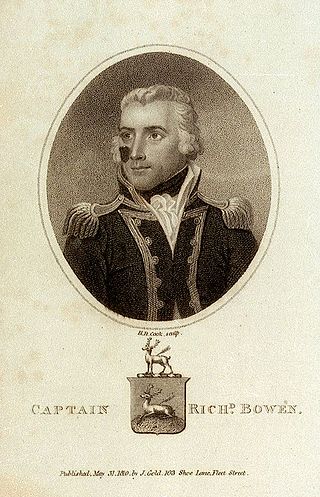
Richard Bowen was an officer of the Royal Navy who served during the American War of Independence and the French Revolutionary Wars. Bowen saw service with Horatio Nelson, and was killed fighting alongside him at the Battle of Santa Cruz de Tenerife.
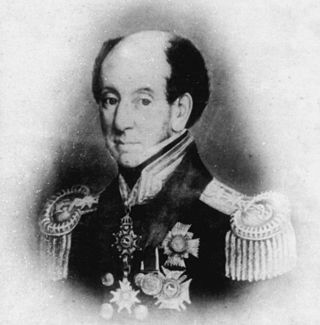
Sir James John Gordon Bremer was a British Royal Navy officer. He served in the Napoleonic Wars against France, the First Anglo-Burmese War in Burma, and the First Opium War in China.
Captain Sir Charles Marsh Schomberg was an officer of the British Royal Navy, who served during French Revolutionary and Napoleonic Wars, and later served as Lieutenant-Governor of Dominica.

Admiral Sir Pulteney Malcolm was a British naval officer. He was born at Douglan, near Langholm, Scotland, on 20 February 1768, the third son of George Malcolm of Burnfoot, Langholm, in Dumfriesshire, a sheep farmer, and his wife Margaret, the sister of Admiral Sir Thomas Pasley. His brothers were Sir James Malcolm, Sir John Malcolm, and Sir Charles Malcolm.
Admiral Sir Robert Barlow GCB was a senior and distinguished officer of the British Royal Navy who saw extensive service in the American Revolutionary War, the French Revolutionary Wars and the Napoleonic Wars. He made his name in small ship actions, especially fighting French frigates, of which he captured three. In his later career Barlow served as comptroller of the Navy and was influential at the Admiralty right up to his death. Although born to a middle-class family, Barlow and his siblings made names for themselves and two of Barlow's daughters married into the naval aristocracy. His grandson, Robert Barlow, was a first-class cricketer and army officer.

William Brown was an officer of the British Royal Navy who served in increasingly senior positions during a long period from the American Revolutionary War, including the French Revolutionary War, and until the Napoleonic Wars. He began his naval career as a servant to Captain Philemon Pownoll in the frigate HMS Apollo and became a midshipman after two years. He then served on HMS Resolution with Lord Robert Manners and came home with him in HMS Andromache. He spent the next five years ashore in peacetime. After a brief time on HMS Bounty he was taken off by the First Lord and moved to HMS Ariel before Bounty sailed. He was then moved to HMS Leander, where he was commissioned by Admiral Peyton in 1788. He later captained a series of ships serving in the Mediterranean Sea, the North Sea, the Channel Fleet and then the Mediterranean, again with Lord St Vincent. He captained HMS Ajax in the Blockade of Brest and the Battle of Cape Finisterre and then at Cadiz at Nelson's personal request. After Trafalgar he had a series of shore postings as Dockyard Commissioner at Malta and Shearness before being made Commander in Chief of the Channel Islands and then Jamaica where he died.
Admiral Sir Barrington Reynolds was a senior and long-serving officer of the British Royal Navy who went to sea with his father aged only nine during the French Revolutionary Wars and was captured by the French aged eleven. Returning to service on his release soon afterwards, Reynolds experienced the successive deaths of his elder brother and his father on active service during the Napoleonic Wars as well as severe bouts of ill-health himself. Leaving the service at the end of the war, Reynolds returned to the Navy in the 1840s after an absence of thirty years and played a major role in the final destruction of the illegal trade in African slaves to Brazil. Reynolds was honoured for this service and retired again to his family seat in Cornwall, where he died aged 75.
The Honourable Sir Henry Duncan KCH, CB was a prominent Royal Navy officer of the early nineteenth century. The second surviving son of the highly regarded Admiral Adam Duncan, 1st Viscount Duncan, who defeated the Dutch Navy at the Battle of Camperdown in 1797, Duncan achieved a successful career in his own right, operating with great success against French and Italian shipping and shore fortifications in the Mediterranean during the Napoleonic Wars. For his services he was knighted and given numerous honours before dying at the young age of 49 from a sudden apoplexy in 1835.

Admiral Sir James Hillyar KCB KCH was a prominent British Royal Navy officer of the early nineteenth century, who is best known for his service in the frigate HMS Phoebe during the Napoleonic Wars and the War of 1812. While in command of Phoebe, Hillyar was present at the Invasion of Ile de France in 1810, was heavily engaged at the Battle of Tamatave in 1811 and captured the USS Essex off Valparaíso in Chile in 1814. In addition, Hillyar was engaged in numerous other operations, his first battle occurring in 1781 off Boston. He remained in the Navy until his death in 1843, and was active at sea during the 1830s, commanding fleets in the North Sea and off Portugal. He was knighted twice and two of his sons later became full admirals, Charles Farrell Hillyar and Henry Shank Hillyar.
William Prowse CB was an officer of the Royal Navy, who saw service during the American War of Independence, and the French Revolutionary and Napoleonic Wars. Rising from humble origins and joining the navy as an able seaman, he had a highly active career, serving under some of the most famous naval commanders of the age of sail, and participating in some of their greatest victories. He was at Grenada and Martinique under Byron and Rodney, the Glorious First of June under Howe; and commanded ships at Cape St Vincent under Jervis, Cape Finisterre under Calder and Trafalgar under Nelson. He finished his career by serving with distinction in the Mediterranean, and died with the rank of Rear-Admiral.

Admiral of the Fleet Sir George Martin was an officer of the Royal Navy who saw service during the American War of Independence, and the French Revolutionary and Napoleonic Wars. During his long naval career he took part in several significant battles, for which he was awarded a number of honours and promotions; he commanded ships at Cape St Vincent and Cape Finisterre.

Sir William Hotham GCB was an officer of the Royal Navy who saw service during the French Revolutionary and Napoleonic Wars.
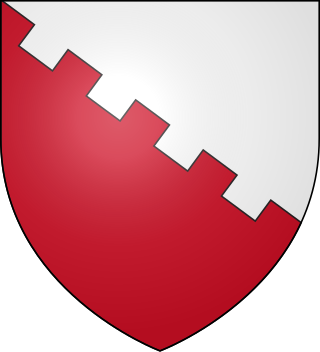
Sir Courtenay Boyle, KCH was an officer of the Royal Navy during the French Revolutionary Wars. In 1807 he served as a Member of Parliament for Bandon.
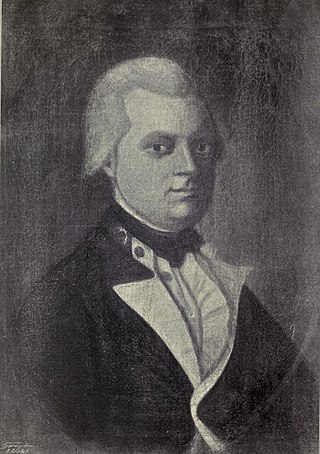
Rear-admiral Bartholomew James was an English naval officer and writer.

Captain James Hawker was an English officer in the Royal Navy. After service on the Shrewsbury and Sheerness, he was appointed first lieutenant of the Colchester at the end of 1755, and was posted in 1768. With the Iris he fought a drawn battle with La Touche Treville in the more powerful frigate Hermione off New York in 1780. He commanded the Hero in Porto Praya under Commodore George Johnstone in 1781, after which he had no further service.
Attribution: